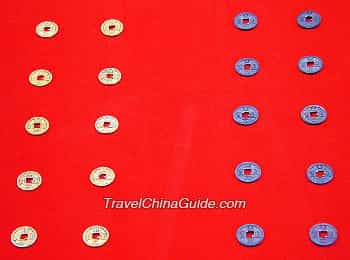Kai Yuan Tong Bao
 |
Gold and silver coins inscribed with
'Kai Yuan Tong Bao', Tang Dynasty |
Kai Yuan Tong Bao is a kind of coin circulated during the
Tang Dynasty (618 - 907). Kai Yuan means the opening of a new epoch and Tong Bao is the treasure in circulation. Kai Yuan Tong Bao is also known as Kai Tong Yuan Bao. The former was read up and down and from right to left while the latter was read clockwise from 12o'clock. This money had two features from its predecessors. Firstly, the coin was no longer named according to its weight. Secondly, the writer of the characters on the coin was recorded in history books for the first time. Kai Yuan Tong Bao was written by Ouyang Xun, the top one among the four calligraphy masters of that time. From poets and other records, we can see that this coin enjoyed high praise for its artistic value.
Kai Yuan Tong Bao's size, weight and the accordance of name with the form made it not only the main currency of the Tang Dynasty but also the norm of the coin in the next dynasties. It was claimed the most successful money in Chinese history. Since its first mintage, it had been used through out the Tang Dynasty without discontinuity, which was rare in the monetary history. People's preference for it diminished not even the least after Tang Dynasty's collapse. Till Hong Xi'an Tong Bao in 1916, this form of money had experienced nearly 1300 years.
Fei Qian (Flying Money)
![''Kai Yuan Tong Bao'']() |
Gold coins inscribed with
characters 'Kai Yuan Tong Bao' |
The Tang Dynasty was one of the most enchanting times in Chinese history. China was the commercial center of Asia. Kai Yuan Tong Bao was circulated in many countries that had close commercial tie with the Tang Dynasty. The outflow of the coins caused money shortage in China so during the reign of Emperor Xi'an Zong (806-820) the government practiced the earliest transfer method, fei qian, namely flying money.
There were two types of fei qian. One was state-owned and the other was private bankers. Special offices were set by the government for transfer and encash. Businessmen could cash in at any time with the paper receipt in any one of the over 40 offices in the country. Unlike the state-owned ones, the private bankers differentiated themselves by the fact they did not charge any fee for encash of fei qian. Their profit came from the interest as a result of slow transportation and time lag of one or two months before a fei qian was finally cashed in.
Melting Buddha Statues for Mintage
There were two emperors in the Chinese history who ordered to melt Buddha statues for mintage. And the first one was Emperor Wu Zong of Tang Dynasty. Buddhism was so popular during the Tang that hundreds of thousands tons of bronze were used for Buddha statues. Nearly all bronze were collected by the Buddhist temples and there was no bronze for mintage. Unlike most emperors of Tang, Emperor Wu Zong did not believe in Buddhism and he claimed, "It is the Buddha that impoverished my country." In 845 Emperor Wu Zong ordered to melt Buddha statues for mintage. At first, people were shocked but when the circulation of the currency went smoothly and the riches increased, people were grateful to this wise emperor.
During the Five Dynasties, another wise sovereign, Emperor Shi Zong of Later Zhou, commanded to melt Buddha statues for mintage. Many Buddhist believers and even ministers in court were against this order but Emperor Shi Zhong defended himself by saying, "The Buddha is determined to bring happiness to all flesh. If he is alive, he would sacrifice his own life for others, not to mention his statues?" Upon hearing this, the objectors were left speechless but to obey.
- Last updated on Aug. 08, 2022 -
